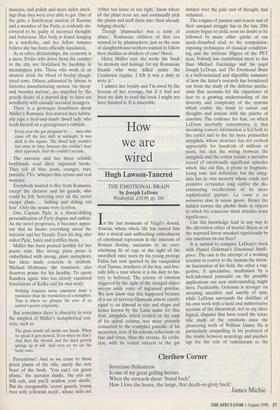How we are wired
Hugh Lawson-Tancred
THE EMOTIONAL BRAIN by Joseph LeDoux Weidenfeld, £1 8.99, pp. 384 In the last moments of Virgil's Aeneid, Aeneas, whose whole life has turned him into a stoical and unflinching embodiment of emotional repression in the interests of Roman destiny, succumbs to an over- whelming fit of rage at the sight of the swordbelt once worn by his young protégé Pallas but now sported by his vanquished rival Turnus, murderer of the boy, and bru- tally kills a man whom it is his duty to his- tory to befriend. The release of emotion triggered by the sight of the charged object sweeps aside years of ingrained gravitas. We now know that this happened because of a sac of nervous filaments almost exactly equal to an almond in size and shape and hence known by the Latin name for that fruit, amygdala, which nestled on the cusp of his spinal column, was more potently connected to the crumpled pancake of his neocortex, seat of his solemn reflections on fate and virtue, than the reverse. So evolu- tion, with its vested interest in the gut instinct over the pale cast of thought, had ordained.
The enigma of passion and reason and of their unequal struggle has in the late 20th century begun to yield, soon no doubt to be followed by many other quirks of our spark-disturbed clod, to the compulsion- exposing techniques of classical condition- ing and the intricate filigree of the PET scan. Nobody has contributed more to this than Michael Gazzaniga and his pupil Joseph LeDoux, and The Emotional Brain is a well-sustained and digestible summary of how the latter's research has broadened out from the study of the defence mecha- nism that accounts for the experience of fear to a growing understanding of the diversity and complexity of the systems which enable the brain to colour our thoughts and actions with the palette of emotion. The evidence for fear, on which LeDoux inevitably concentrates, is that incoming sensory information is fed both to the cortex and to the far more primordial amygdala, whose structure has not evolved appreciably for hundreds of millions of years, but that the wiring between the amygdala and the cortex retains a narrative record of emotionally significant episodes which, like old film, is prone to fragment, losing tone and definition; but the amyg- dala has its own memory whose crude and primitive certainties long outlive the dis- criminating recollections of its more sophisticated partner. La coeur a ses memoires dont la raison ignore. Hence the hidden terrors the phobic finds in objects to which his conscious mind attaches scant significance.
Can this knowledge lead in any way to the alleviation either of mental illness or of the wayward havoc wreaked capriciously by our emotions on our lives?
It is natural to compare LeDoux's book with Daniel Goleman's Emotional Intelli- gence. The one is the attempt of a working scientist to convey to the layman the intrin- sic fascination of his field, the other a sug- gestive, if speculative, meditation by a well-informed journalist on the possible applications our new understanding might have. Predictably, Goleman is stronger on arresting anecdote and suavity of spin, while LeDoux surrounds the distillate of his own work with a lucid and authoritative account of the theoretical, not to say ideo- logical, disputes that have vexed the scien- tific study of the emotions since the pioneering work of William James. He is particularly compelling in his portrayal of the rivalry between neurology and psychol- ogy for the role of vademecum to the mind/brain (while at the same time discard- ing such neurological canards as the exis- tence of a comprehensive 'limbic system', globally responsible for the emotional life), less certain in his review of the philosophi- cal perplexities which hedge round the phenomenon of emotional feeling — per- plexities whose intensity and fascination both stem ultimately from the opacity gen- erated by the admission of consciousness as a category in the scientific understanding of the word.
Both books have the merit of insisting, in the teeth of the current tyranny of cultural- ist dogma, that the way to understand how we work is to look at how we are built, not at what we watch on television. Where Goleman is proclamatory, LeDoux is cau- tious, however. Of course, we cannot be harmed by understanding how our feelings are driven, but it is not obvious that we can be much helped. If natural selection has so wired us that we are run by a committee of our lower organs against the vain protests of our intellects, then there is probably lit- tle that we can do about it now.
But little is not nothing. The truth may not make us free, but it may well allow us to anticipate and avoid many of the disas- ters which our ignorance would otherwise have exacerbated. As the post-political phase of human history gets properly under way, administrators and educators will become more and more concerned with the facts that LeDoux exposes and the prospects that Goleman holds out. No doubt the jargon of neurology will gradual- ly infiltrate and perhaps even supplant the homely categories of 'folk psychology'. And we will still need poets to elevate the pro- ceedings with the redemptive benison of classical art.



























































 Previous page
Previous page